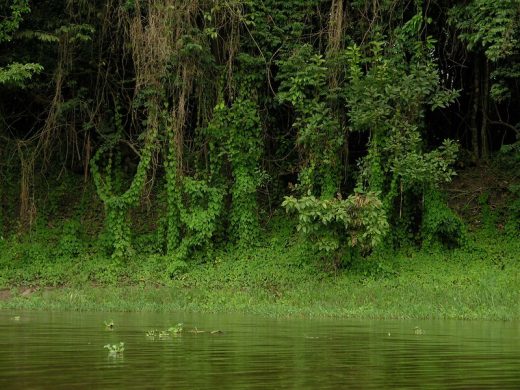Videnskaben er klar: den historisk slemme tørke i Sao Paulo er forårsaget af skovhugst i Amazonas, mener skov-tænketank. Brasilien kan enten vælge at standse afskovningen eller tilpasse sig hyppigere og værre tørker, skriver CIFOR på sin hjemmeside.
The role of tropical deforestation in global climate change has been the subject of much international discussion and debate in the media and in policy forums like the UN Climate Change Convention, writes Center for International Forestry Research Tuesday.
However, the role of deforestation in local climate change has received much less attention.
Now, with southern Brazil suffering from unprecedented drought, attention is turning toward more localized impacts of deforestation.
Dr. Antonio Nobre, a scientist at the Brazilian National Space Research Institute, released a report, “The Future Climate of Amazonia,” that linked the current drought to deforestation in the Amazon Basin. Politicians are questioning these conclusions. What does the science say?
RELATIONSHIP BETWEEN TREES, RAINFALL?
In 2009, CIFOR scientists Douglas Sheil and Daniel Murdiyarso summarized the scientific understanding of the relationship between forests and rainfall in an article in BioScience. At the time, the link between deforestation and declining rainfall was still uncertain.
There were indications in the scientific literature that deforestation disrupted cloud formation and accentuated rainfall seasonality in areas that have distinct wet and dry seasons.
Evidence was accumulating that a significant amount of rain falling in the interior of continents was recycled—meaning that the water had previously fallen near the continental margins, been pumped back into the atmosphere by vegetation, and was falling again.
This was true of many areas of the world. In the US, 50 percent of the rainfall in the Midwest was recycled; in the Sahel of West Africa, the figure was 90 percent.
However, a significant amount of water falling as rainfall in some areas is not recycled. For example, only about 30 percent to 60 percent of the rainfall is recycled water in the Amazon Basin.
One of the mysteries at the time of Sheil and Murdiyarso’s article was how flat lowlands in the interior of continents maintained wet environments.
If recycling is the key mechanism for rainfall reaching the interior of continents, then rainfall should decrease as distance from the coast increases. Indeed, in many places in the world, this phenomenon can be observed—except where there are extensive areas of natural forests.
A ‘BIOTIC PUMP’
In the mid-2000s, two physicists—Anastassia Makarieva and Victor Gorshkov of the Petersburg Nuclear Physics Institute—proposed a novel physical phenomenon to explain how tropical rainforests keep the interior of continents humid. In these regions, forests have higher evaporation rates than other vegetation types.
As the humid air rises from forests into the atmosphere, the water vapor condenses. This decreases the volume of the air, and the air pressure plummets.
Because air flows from places of high pressure to those of low pressure, this decrease in pressure sucks additional dense air in, and so forests draw in moist air from elsewhere (for example, from over the oceans).
This additional moist air rises and condenses in turn, generating a situation where a large proportion of the water condensing as clouds over wet areas is drawn in from elsewhere.
Makarieva and Gorshkov call this phenomenon a “biotic pump,” and they demonstrated it with data from the Amazon River Basin and the Congo River Basin in Equatorial Africa. Other scientists began looking at this phenomenon and provided additional evidence for the existence of a biotic pump.
In 2012, Dominick Spracklen and others looked across the tropics and found that when air passed over extensive vegetation, it produced at least twice as much rain as air that passed over little vegetation.
Spracklen and others went further and integrated Makarieva and Gorshkov’s physical phenomenon into a climate model to see the effect of deforestation on rainfall. (Corrected) Makarieva and others went further and integrated this physical phenomenon into a climate model to see the effect of deforestation on rainfall.
Because the primary air flow into the Amazon Basin is from the Atlantic Ocean, and because most of the deforestation occurs on the eastern and southern flanks of the Basin, there is cause for concern. Their simulation showed that continued deforestation in the Amazon Basin would lead to decreased rainfall.
RIVERS IN THE SKY
The idea that water flows around the atmosphere in observable pathways is not new; it was first proposed in an article by Reginald Newell and others in Geophysical Research Letters in 1992. Several studies have confirmed these and show, in addition, that these “aerial rivers” are responsible for the rainfall in southeastern Brazil.
Contrary to surface rivers, these aerial rivers gain water from the vegetation as it pumps water out of the soil and lose it through rainfall.
Several groups have been working on this phenomenon during the past decade, and our understanding of the importance of these aerial rivers has grown. In particular, we now understand how these massive flows of water through the atmosphere relate to rainfall around the South American continent.
To cite one study, Josefina Moraes Arraut and others from the Brazilian Institute of Space Studies showed that as the air masses move across the Amazon, enhanced by the biotic pump, they eventually encounter the Andean Cordillera, where they veer south and eventually east to bring humidity from the Amazon Basin to southeastern Brazil and northern Argentina.
Thus, maintaining the biotic pump in the Amazon is essential for ensuring water delivery to southeastern Brazil.
WHAT SHOULD POLITICIANS DO?
The governor of São Paulo expressed skepticism over the role of the Amazonian deforestation in the drought affecting his state in an article that appeared in The Wall Street Journal last month.
Yet the science is clear, and it goes beyond simple correlation among observations: The mechanisms of water circulation between the Amazon Basin and the southern regions east of the Andes are well established.
As deforestation in the Amazon continues, rainfall in the southern part of Brazil will continue to be affected. The Amazonian forest will continue to lose its ability to regulate the climate and ensure a flow of water to the southeastern part of the country. Additionally, deforestation in the Brazilian Amazon will affect northern Argentina, so the problem has an international dimension.
Politicians need to balance development objectives and environmental concerns, but in this case it is fairly clear that the two go hand in hand. Thus, there appear to be two options for wise action.
On the one hand, politicians can decide to stop the problem at its root cause by decreasing Amazonian deforestation and promoting rehabilitation of degraded forest in order to maintain the atmospheric circulation patterns.
A second possibility is to integrate expected shortfalls of rainfall into planning and adapt the economic systems of the south to accommodate more frequent droughts. This means improving water storage and distribution while reducing waste. A combination of these two approaches is probably warranted.
There is a third option: One could ignore the problem until it goes away. Climate is variable, and this drought will eventually end. However, it is very likely that this is not an isolated event, and the science suggests that there is more to come.














